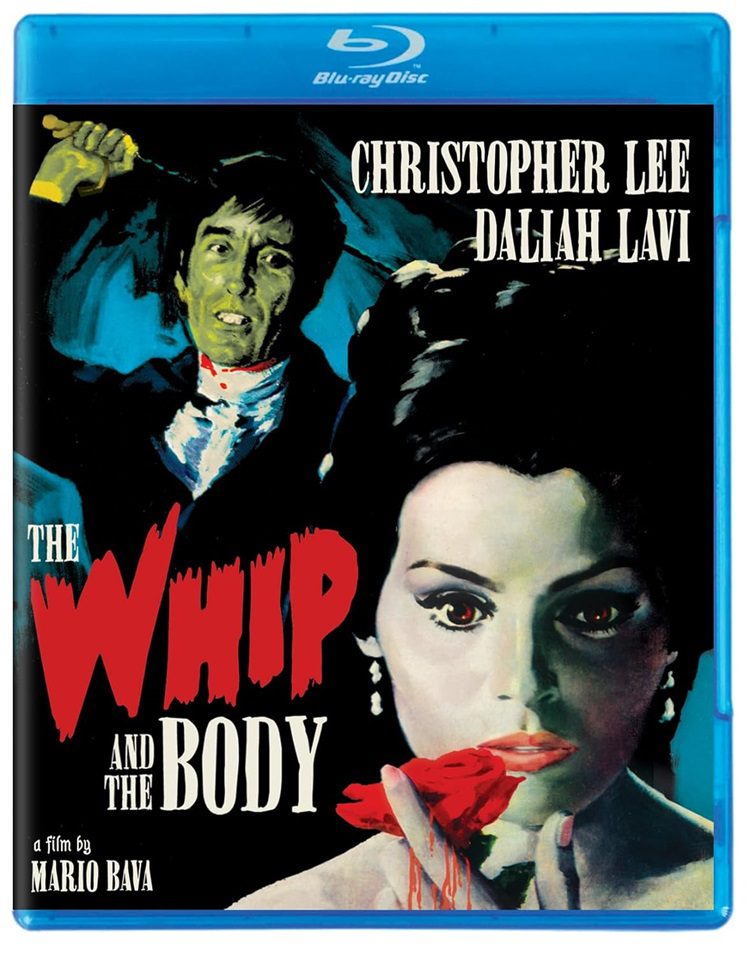
The thing about Mario Bava is that he became something of a bridge between classical and modern horror. He made films like Black Sunday (1960) that look and feel like the gothic horror from those Universal Monster movies put out three decades earlier. Then he essentially invented the giallo with Blood and Black Lace (1964) ushering in a wave of horror films that highlighted style over substance and continually pushed the envelope in terms of sex and violence. He was a master of visuals, creating stunningly beautiful and often grotesque images with his daring use of camera setups and bold use of color.
Buy The Whip and the Body Blu-rayThe Whip and the Body, made in 1963 is a perfect encapsulation of a genre in transition. It is completely gothic in its look and story, taking place in an old castle and concerning a wayward son returning home. But it is also full of sexual kink and (for its time) graphic violence.
Christopher Lee plays Kurt Menliff, the prodigal son. He was first in line to inherit the estate and engaged to Nevenka (Daliah Lavi), but when he decided to seduce the maid’s daughter and when she committed suicide after he dumped her, Count Menliff (Gustavo De Nardo) disinherited him. After years in exile, he’s come back. He says this is to wish his brother Christian (Tony Kendall) and Nevenka felicitations on their recent marriage, but really he’s hoping to win back his father’s good graces (or at least a part of his inheritance) and possibly Nevenka’s affections.
It is from this second part that the film gets its title. Apparently, the couple previously enjoyed a bit of kink for when she tries to push back his advances with a horsewhip, he takes it away and turns it on her, literally whipping her into a sexual frenzy. And let me tell you, it is quite a thing to watch Christopher Lee in a movie from this time period whip a woman while she writhes and moans in ecstasy. Each time she swears she no longer loves him, Kurt brings out the whip and she has no choice but to moan out her undying love.
Ah, but here’s the twist (and a mild spoiler, though it is also spoiled on the back of the box so I think we can let it pass), Kurt is found murdered only a few nights after he’s returned. He was stabbed by the very knife the maid’s daughter killed herself with. The maid (Harriet Medin) kept the knife, along with a rose inside a glass case. Naturally, she’s the first suspect, but everyone has their reasons to want Kurt dead.
Or is he dead? Nevenka keeps seeing him staring at her through windows and claims he’s been creeping into her bedroom at night. Is she seeing things? Has his ghost come back to seek his revenge? Or did he fake his own death for some nefarious reason? This central mystery never really develops in any interesting way. I never really cared about what happened to Kurt or who did what it to him.
But what makes the film worth watching is Bava’s use of setting, mood, and color. Like so many of his films, it is bathed in blues, reds, greens, and blacks. The castle’s sets are enormous and intricately designed. Bava always seems to find the perfect place to set his camera to give each scene a most interesting look. You could spend a lifetime dissecting each shot, marveling at its use of color, light, and setup.
Bava made better films in his illustrious career, but The Whip and The Body is a fascinating glimpse at a director at a crossroads, working out new and interesting ways to make horror. He made The Girl Who Knew Too Much earlier that same year which many consider to be the true first giallo, and then he made Blood and Black Lace (the film I’d consider to take that honor) just one year later. All of these films find the director experimenting with his signature style and various amounts of sex and violence. Each of them would have a huge influence on the horror genre for years to come.
Kino Lorber presents The Whip and the Body with the same 4K transfer that was on the recent British release of the film from 88 Films in 2023. Extras include an excellent audio commentary from Tim Lucas, both the English and Italian dubs of the film, and several trailers for other Kino Lorber films.